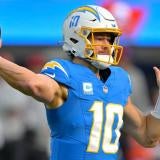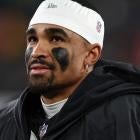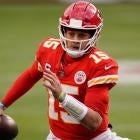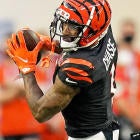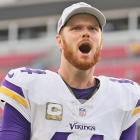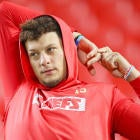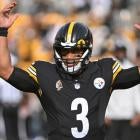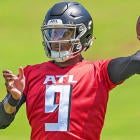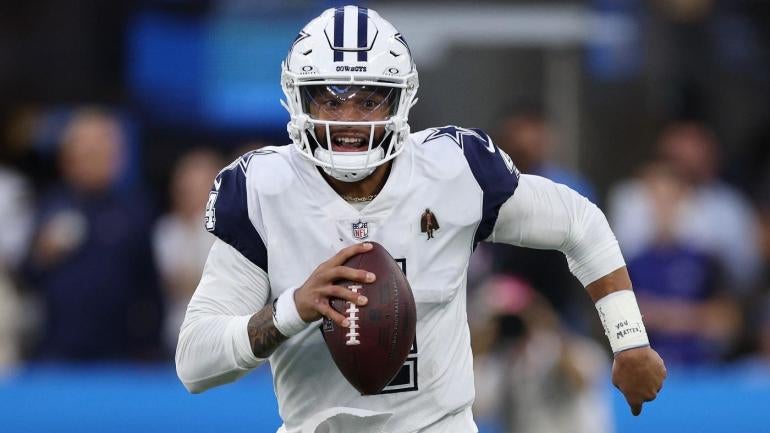
FRISCO, Texas -- Despite the Dallas Cowboys' 4-2 record, which positions them within 1.5 games of first place in the NFC, there has been a lot of handwringing about offensive frustrations and the team's overall offensive identity in 2023. One of the main areas of consternation for the Cowboys is their red zone offense given their 39.1% red zone touchdown rate ranks as the seventh-worst in the league.
However, they may have stumbled into a solution to give their offense inside the 20 some more juice in their 20-17 road victory at the Los Angles Chargers on "Monday Night Football": more designed quarterback run plays for Dak Prescott. Facing fourth-and-one from the Chargers' 18 in the first quarter, Prescott kept the football on a read-option play and zoomed into the end zone untouched as the field parted in front of him. Essentially the entirety of the Chargers defense collapsed on Pollard while a couple stray defenders followed Lamb off to the right after he was sent in motion. This sequence evened the game at seven just under halfway through the opening quarter.
.@DAK keeper for the 18-yard TD run!
— NFL (@NFL) October 17, 2023
📺: #DALvsLAC on ESPN/ABC
📱: Stream on #NFLPlus https://t.co/cKH8Z3jhNB pic.twitter.com/d8HnyMfx9W
"I had CeeDee [Lamb] in motion as an option," Prescott said postgame in Week 6. "The defensive end took [running back] Tony Pollard. The two other guys ran towards CeeDee. It just allowed me to cut up field. Great play call, honestly. They were going all-out. It wasn't necessarily sound on their end. Somebody has to have the quarterback, but not showing my legs, not running early in the year, I think played a part in that. I was just able to go get it."
That play didn't happen by accident. Prescott talked about needing to use his legs more in the red zone after the Cowboys' shocking 28-16 loss against the Arizona Cardinals in Week 3, and head coach Mike McCarthy noticed something about Los Angeles' defensive alignment on film that made the play an easy choice for him at that early, critical juncture.
"If you look at the design of their defense, their edge rushers are extremely wide, so the focus was on some of the things we wanted to do inside," McCarthy said postgame on Monday. "[Prescott] did a good job of taking that and trusting his feet, coming out of there and extending plays. ... That's part of the issue of playing the 3-4. That's probably as wide as we had seen all year. ... Stepping up and out [of the pocket], I thought he did a really nice job of that tonight."
Prescott's scrambling abilities didn't just result in rushing yards. Their longest play from scrimmage Monday night happened after Prescott spun out of sack and stepped up in the pocket to check the football down to running back Tony Pollard, who after a broken tackle, hit the gas for a 60-yard gain.
"As I got out, I saw some grass in front of me to potentially run," Prescott said. "But always just trying to keep my eyes down field, look back, looking for a tight end, a receiver coming across, and here comes Tony out of the backfield. Threw it to him and he then went and got a lot more than the play that I made. .... Huge play."
Prescott also extended a second-and-goal play from the two by backing up with his legs before arching a two-yard touchdown pass to the left corner of the end zone to wide receiver Brandin Cooks to put the Cowboys back in front of the Chargers 17-10 with 11:20 left in the game.
PRESCOTT TO COOKS. @DallasCowboys take the lead
— NFL (@NFL) October 17, 2023
📺: #DALvsLAC on ESPN/ABC
📱: Stream on #NFLPlus https://t.co/cKH8Z3jhNB pic.twitter.com/VdX89XRFkG
"That's been one of the better parts of Dak's game, playing above what we call the 2.3 [seconds], the natural length of a play," quarterback coach Scott Tolzien said on Oct. 18. Tolzien was a backup quarterback for McCarthy's Green Bay Packers from 2013-2015. "That definitely came to life against the Chargers. It's something we have been preaching as a squad in every Coach McCarthy system. That has always been a big part of the offensive plan, just to get above that 2.3 [seconds] and distort the defense a little bit. I thought we did a good job of that on Monday night."
Prescott has never been much a of a runner in the NFL, averaging 3.8 carries per game and 19 rushing yards per game in his first five seasons from 2016. Although he totaled 24 rushing touchdowns in that time, an average of just under five a season (4.8 to be exact), all of them occurred in the red zone. Since his gruesome ankle injury he suffered early in 2020 against the New York Giants, his carries per game (3.3) and rushing yards per game (12.1) haven't changed considerably, but the touchdowns have. Prescott only has three since 2021, an average of one year. To be fair, there are still 11 games remaining in Dallas' 2023 regular season. The Chargers clearly weren't looking for Prescott to run in Week 6 on his read-option touchdown as they all crashed toward Pollard. Sprinkling that element in more could be in the cards. Prescott was a strong rusher, for his position at Mississippi State: he totaled 504 carries that went for 2,403 rushing yards and 37 rushing touchdowns across his three seasons (37 games) as a starting quarterback from 2013-15. That averages out to 14 carries a game, 65 rushing yards a game and one rushing touchdown a game.
"He was terrific," offensive coordinator Brian Schottenheimer said Oct. 17 of Dak's rushing in Week 6. "It's something that has been missing, but it's not something that had shown up as much until last night [the Week 6 "Monday Night Football" win at the Chargers]. ... Every game is different, we always carry [option run plays], but they don't always make it off the card. Each game is different. We're very selective with it. Nobody wants to have the quarterback have to carry it a ton, but he has the ability to hurt people with his legs, and he's done that historically. We're not back to the Mississippi State days in terms of all the carries that he's used to, but it's good to show that we have the capability of doing that, and to have it be a touchdown in the red zone and things like that was something that we were excited about."
McCarthy went out of his way to detail the difference between Prescott's improvisation and actually dialing up running plays for his 30-year-old quarterback following their Week 6 victory, making it clear his legs will be a "just in-case" ingredient in the Cowboys offense instead of a featured element.
"Running and scrambling from my viewpoint are different," McCarthy said on Oct. 17. "Scrambling is part of the passing game, and it's the way we train. Called runs, we are selective when we do it. He was very productive on the touchdown run and that was a big play in the game. You won't see me call 12 quarterback runs in a game. This defense [the Chargers], we have a lot of respect for their pass rush. We obviously gave up five sacks, but with the wide rushers [their defensive ends were aligned further down the line of scrimmage than most teams] there is definitely opportunity there to come up in the A and B gaps [the middle of the offensive line. I though [Prescott] did a good job working through his progressions, escaping and activating the scramble drill."
Another reason to mix Prescott's legs higher up in the game plan on a weekly basis is the stress a running, scrambling quarterback can put an opposing defense. Baltimore Ravens quarterback Lamar Jackson, who plays for an AFC team, improved to 16-1 in his career against NFC opponents after a resounding 38-6 victory against the NFC North-leading Detroit Lions on Sunday. It's hard to simulate that type of quarterback in practice. Cowboys defensive coordinator Dan Quinn confirmed as much when asked about how defenses approach dealing with mobile quarterbacks.
"It's tough because there are different ways you go about it," Quinn said on Oct. 17. "There are certain guys that want to get outside the pocket to go create because there is really like two plays that happen. Some are the scramble, not across the line, but buying time for another route to take place and throw it down the field. That's one element, when you get outside the pocket and staying alive to throw it. The second one is, a lot of times it can be when you're in man-to-man, and somebody's back is turned and that player doesn't see the quarterback. Those ones can really hurt you, especially on a third-down conversion [Prescott's touchdown run came on fourth down].
You thought you had the right people guarding them in the right spots and all of the sudden, he slips out to go. For a guy like Dak, who is an athlete, who can do it like on the touchdown run and other ones where he stayed alive to throw. For a defense, here is how we coach those plays. The first one when the dropback is started and the second on begins when the quarterback breaks contain. You may be covering someone for a long time like 2.5 seconds, but now you are getting into 3.5, 4 seconds. That's where you see deep routes and crossing ones. … Sometimes you want to key someone to keep the quarterback in the pocket if they are exceptional at that part and other times it's sheer running and somebody inside the pocket just finding a lane. Those are difficult too because you want a quarterback to be able to run laterally, not downhill. If they run laterally, the chances are the rest of your speed on defense can get them. If you're going down main street and the quarterback splits it, that's when big plays can happen."
In the eyes of Prescott himself, incorporating his mobility into games going forward is something that could lift what has been a somewhat inefficient Cowboys offense into a more reliable unit.
"That's how the game unfolded," Prescott said of his scrambles. "A little bit of maybe a conscious effort by myself. Just coming off [a 42-10 loss at the San Francisco 49ers in Week 5], realizing that maybe that's something I could use and we could use. I think it's something that we could benefit from."








